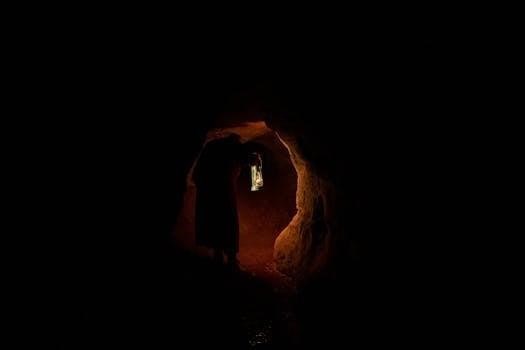Avatar⁚ Frontiers of Pandora Trophy Guide
Welcome to our comprehensive guide for obtaining all the trophies in Avatar⁚ Frontiers of Pandora! This guide will assist you in navigating Pandora and unlock all 42 trophies, including the prestigious platinum. The game features 32 base game trophies and an additional 10 trophies across two DLC packs. Embark on your journey to complete all challenges!
Trophy Overview
Avatar⁚ Frontiers of Pandora presents a diverse range of trophies, designed to test your skills and exploration within the vibrant world of Pandora. The trophy list comprises 42 trophies in total, which include 16 bronze, 19 silver, 6 gold, and the coveted platinum trophy. The base game offers 32 trophies which focus on completing the main story, side quests, collecting various items, and engaging in combat. A significant portion of the trophies involves exploring the open world, discovering hidden locations, and interacting with the environment. Furthermore, trophies are tied to specific tasks such as crafting items of legendary rarity, mastering combat techniques, and completing skill challenges. The game also encourages players to immerse themselves in the lore by discovering collectibles scattered throughout Pandora. There are also trophies that require you to interact with the environment in particular ways, like finding all Tarsyu Saplings or Ancestor Skills locations; Be prepared to spend a lot of time exploring every corner of this amazing world in order to get them all. Achieving 100% completion will be a challenging but rewarding experience. The game’s trophy system encourages a thorough playthrough that rewards exploration and experimentation.

Platinum Trophy⁚ Song of the Sarentu
The ultimate achievement in Avatar⁚ Frontiers of Pandora is the “Song of the Sarentu” platinum trophy. This coveted trophy is awarded to players who demonstrate complete mastery of the game by unlocking all other trophies. It signifies a player’s dedication to exploring every corner of Pandora, mastering all gameplay mechanics, and completing all challenges presented by the game. Earning the platinum trophy requires a significant investment of time and effort, as it involves completing all base game trophies and those associated with DLCs, if applicable. It’s not just about finishing the main story; it encompasses a wide range of activities, such as collecting all items, mastering combat, completing all side quests, and fully exploring the open world. The “Song of the Sarentu” trophy is a testament to the player’s skill, perseverance, and thorough engagement with the game. It serves as a badge of honor, signifying a complete journey through the world of Pandora and mastery of all its trials. For trophy hunters, this is the ultimate goal and reward;
Base Game Trophies (32 Total)
Avatar⁚ Frontiers of Pandora features a total of 32 trophies within its base game, each representing a different aspect of gameplay and exploration. These trophies are your primary focus as you delve into the world of Pandora and are essential for achieving the platinum trophy. They range from straightforward tasks, such as completing main story missions, to more complex challenges, like mastering combat techniques and fully exploring the open world; You’ll encounter trophies related to the main storyline progression, side quests, and exploration, encouraging you to thoroughly experience everything the game has to offer. Furthermore, some trophies will be tied to specific gameplay mechanics, like crafting, hunting, and interacting with the unique flora and fauna of Pandora. These trophies are designed to guide you through the game’s core systems, rewarding you for successfully mastering each one. Collecting all 32 base game trophies is a crucial step towards achieving the “Song of the Sarentu” platinum trophy and completing your adventure in Avatar⁚ Frontiers of Pandora. Prepare for a diverse and engaging journey across Pandora to accomplish them all.
Collectible Trophies
Within Avatar⁚ Frontiers of Pandora, several trophies are tied to collecting various items scattered throughout the vast world. These collectibles often require exploration and keen observation skills to locate, adding a layer of discovery to your gameplay experience. One notable example is the “Doll Collector” trophy, which involves finding all nine Windswept Dolls, also known as Kametire Dolls. These dolls are hidden across the landscape and require a thorough search to obtain. Additionally, there are trophies related to finding all Tarsyu Saplings, which are crucial for unlocking Ancestor Skills, further encouraging you to explore every corner of Pandora. Some collectible trophies are also linked to specific side quests, such as the “Sarentu Totems” side quest, which requires you to understand the points of interest. The game also features research stations that must be discovered and completed to unlock certain trophies, emphasizing the importance of completing all exploration-related side quests. Collecting these items is not just about the trophies; it also provides deeper insight into the lore of Pandora and its inhabitants, making it a rewarding activity.
Quest-Related Trophies
Many of the trophies in Avatar⁚ Frontiers of Pandora are directly tied to completing specific quests, both main story missions and side quests. These trophies encourage players to fully engage with the narrative and explore the diverse storylines offered within the game. For instance, completing the main storyline will unlock several key trophies, progressing as you advance the plot and overcome challenges. Side quests also play a crucial role in obtaining trophies, often requiring you to assist various characters and explore different regions of Pandora. Some side quests, like “Sarentu Totems,” involve collecting items or completing objectives to earn a trophy. These quests can range from simple tasks to more complex missions that require careful planning and execution. Engaging with these quests will not only earn you trophies but also deepen your understanding of Pandora’s culture and the conflicts within it. The “Flight of Memories” quest is also linked to finding a certain ingredient, which in turn also contributes to a trophy, showing how interconnected the quest system is to the trophy system. Therefore, fully completing all quests is essential for a complete trophy collection.
Combat Trophies
Combat trophies in Avatar⁚ Frontiers of Pandora focus on your prowess in battle against both RDA forces and the wildlife of Pandora. These trophies challenge you to master different combat techniques and use the environment to your advantage. One such trophy involves eliminating enemies using specific skills, requiring you to experiment with your Na’vi abilities. You might need to defeat enemies with your ikran or use stealth to take down RDA outposts without alerting them. Another aspect of combat trophies is the need to craft and utilize legendary-tier weapons and gear, rewarding players who invest time in gathering resources and crafting powerful equipment. Additionally, some combat trophies are tied to specific enemy types, requiring you to strategize and adapt your tactics. The combat system is versatile, allowing you to approach encounters in various ways, from direct assaults to stealthy infiltrations. Mastering these techniques and combining different skills is essential to earn all the combat-related trophies. These challenges make sure players are fully engaged in combat and are not just rushing through the game, but are actively developing their combat skills to achieve the best results.

Crafting Trophies
Crafting trophies in Avatar⁚ Frontiers of Pandora emphasize the importance of resource gathering and the creation of powerful gear. These trophies require you to explore Pandora’s diverse environments, collecting various materials to craft weapons, armor, and other essential items. You’ll need to understand the different types of resources and their uses, and become proficient in using crafting tables. One key trophy relates to crafting legendary-tier gear, which demands rare resources and advanced crafting techniques. This encourages players to seek out the most challenging areas of Pandora for high-quality materials. Another trophy may focus on crafting a specific number of items or types of gear, urging you to experiment and master all the crafting recipes. Furthermore, you might find trophies tied to using specific ingredients in your crafts, necessitating a deep understanding of the game’s flora and fauna. Crafting is not just about making gear; it’s about mastering the art of resourcefulness and creating powerful items that help you in your fight against the RDA. These trophies encourage players to engage with the game’s crafting system thoroughly, transforming them into skilled Na’vi artisans.
DLC Trophies (10 Total)
Avatar⁚ Frontiers of Pandora expands its trophy list with 10 additional trophies spread across two downloadable content packs. These DLC trophies often introduce new challenges, areas, and storylines, providing additional content for dedicated players. Expect to encounter trophies that require mastery of new combat techniques, exploration of uncharted regions, or completion of unique quests added in the DLC. These trophies may push your skills further and introduce new mechanics to master. A significant portion of the DLC trophies will likely be tied to the narrative content of the expansions, rewarding players for progressing through the DLC’s main story and side missions. Some trophies may involve collecting new types of resources or crafting new equipment specific to the DLC. There will likely be trophies that require you to overcome challenging new enemies or boss encounters introduced in the downloadable content. You can also expect some trophies to be tied to optional content. These trophies are designed to extend your experience and encourage players to delve deeper into the added content. Successfully completing these will prove your mastery of Pandora.

Tips and Tricks for Trophy Hunting
Efficient trophy hunting in Avatar⁚ Frontiers of Pandora requires a strategic approach. Firstly, focus on completing the main story quests as these often unlock areas and abilities essential for other trophies. Simultaneously, keep an eye out for collectibles, as some are tied to trophies, saving you time later. Regularly check your trophy progress to identify which ones you should prioritize and tailor your gameplay accordingly. Pay attention to the map and use the environment to your advantage. Explore thoroughly, as many areas contain hidden items or side quests that contribute to trophy progress. Engage in combat with different enemy types to hone your skills and unlock combat-related trophies. Utilize crafting and cooking to create powerful gear, as some trophies are tied to these activities. Be sure to engage with all the available side quests, as many are crucial for unlocking trophies. Mastering the game mechanics will help you gain efficiency. Familiarize yourself with skill trees and their benefits early on and plan your build. Finally, don’t hesitate to look up specific trophy guides if you get stuck on a challenging trophy, as this will save you time and frustration.

